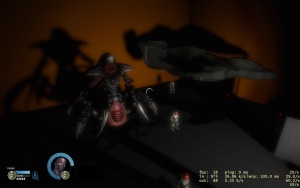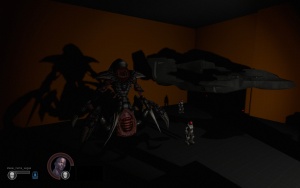env_projectedtexture/fixes
Enabling multiple shadow maps.
Valve's games only allow one projected texture to cast shadows at a time - including the player's flashlight. To surmount this, shadow casting can be disabled on each entity with the enableshadows KV, or for a proper solution a programmer can perform this simple C++ fix:
In CClientShadowMgr::Init() (located in : src\game\client\Clientshadowmgr.cpp, and around line 1293), replace the following:
bool bTools = CommandLine()->CheckParm( "-tools" ) != NULL;
m_nMaxDepthTextureShadows = bTools ? 4 : 1; // Just one shadow depth texture in games, more in tools
With this:
bool bTools = CommandLine()->CheckParm( "-tools" ) != NULL;
m_nMaxDepthTextureShadows = bTools ? 4 : YOUR_CHOSEN_MAX; //with your number
Fixing targeting.
Because the targeting code isn't finished in the SDK, A projected texture will flicker when bound to a target. To fix this, open c_env_projectedtexture.cpp (Located in : src\game\client...) and around (line 174) there is an else block containing an assert and some commented code. Replace the whole block with this:
else
{
// VXP: Fixing targeting
Vector vecToTarget;
QAngle vecAngles;
if ( m_hTargetEntity == NULL )
{
vecAngles = GetAbsAngles();
}
else
{
vecToTarget = m_hTargetEntity->GetAbsOrigin() - GetAbsOrigin();
VectorAngles( vecToTarget, vecAngles );
}
AngleVectors( vecAngles, &vForward, &vRight, &vUp );
}
The server needs code to update the entity with angles on a target as well. Open env_projectedtexture.cpp (Located in src\game\server) and around (line 240) edit the InitialThink() function to recalculate angles towards the target:
void CEnvProjectedTexture::InitialThink( void )
{
if ( m_hTargetEntity == NULL && m_target != NULL_STRING )
m_hTargetEntity = gEntList.FindEntityByName( NULL, m_target );
if ( m_hTargetEntity == NULL )
return;
Vector vecToTarget = (m_hTargetEntity->GetAbsOrigin() - GetAbsOrigin());
QAngle vecAngles;
VectorAngles( vecToTarget, vecAngles );
SetAbsAngles( vecAngles );
SetNextThink( gpGlobals->curtime + 0.1 );
}
Fixing cuts in the projected texture.
When using multiple env_projectedtexture, projected textures might be cut at certain viewing angles. To fix this, force r_flashlightscissor 0 for your mod or map.
You can do this by adding the following code block into the constructor of c_basehlplayer.cpp (located in : src\game\client\hl2...)
ConVarRef scissor( "r_flashlightscissor" );
scissor.SetValue( "0" );
Fixing Parenting
By default, this entity's position only gets updated when it gets turned on. Thus, parenting does not work. To fix this, open c_env_projectedtexture.cpp (Located in : src\game\client...) and around (line 222), comment out the 3 lines like this:
// if ( bForceUpdate == false )
// {
g_pClientShadowMgr->UpdateProjectedTexture( m_LightHandle, true );
// }
and around (line 248) in the Simulate function, change the UpdateLight call to:
UpdateLight( GetMoveParent() != NULL );
Enabling visibility tests
Projected textures are not tested for visibility. To enable AABB-frustum visibility culling, open up clientshadowmgr.cpp (located in : src\game\client\...), and find the function CClientShadowMgr::BuildFlashlight. Add the following highlighted code to the beginning of the function:
void CClientShadowMgr::BuildFlashlight( ClientShadowHandle_t handle )
{
// For the 360, we just draw flashlights with the main geometry
// and bypass the entire shadow casting system.
ClientShadow_t &shadow = m_Shadows[handle];
if ( IsX360() || r_flashlight_version2.GetInt() )
{
// This will update the matrices, but not do work to add the flashlight to surfaces
shadowmgr->ProjectFlashlight( shadow.m_ShadowHandle, shadow.m_WorldToShadow, 0, NULL );
return;
}
VPROF_BUDGET( "CClientShadowMgr::BuildFlashlight", VPROF_BUDGETGROUP_SHADOW_DEPTH_TEXTURING );
// Don't project the flashlight if the frustum AABB is not in our view
Vector mins, maxs;
CalculateAABBFromProjectionMatrix(shadow.m_WorldToShadow, &mins, &maxs);
if(engine->CullBox(mins, maxs))
return;
Removing incorrect culling
The built-in env_projectedtexture culling is broken. If an env_projectedtexture is placed pointing in one direction, and the player turns to face the opposite direction, the light can be seen in the direction that the player is pointing under certain circumstances. YouTube video to demonstrate the issue[1].
The below code in the function CClientShadowMgr::BuildActiveShadowDepthList() in clientshadowmgr.cpp (located in : src\game\client\...), can be commented out to fix this behavior, around (Line 3900):
const FlashlightState_t& flashlightState = shadowmgr->GetFlashlightState( shadow.m_ShadowHandle );
// Bail if this flashlight doesn't want shadows
if ( !flashlightState.m_bEnableShadows )
continue;
// Calculate an AABB around the shadow frustum
/*Vector vecAbsMins, vecAbsMaxs;
CalculateAABBFromProjectionMatrix( shadow.m_WorldToShadow, &vecAbsMins, &vecAbsMaxs );
Frustum_t viewFrustum;
GeneratePerspectiveFrustum( viewSetup.origin, viewSetup.angles, viewSetup.zNear, viewSetup.zFar, viewSetup.fov, viewSetup.m_flAspectRatio, viewFrustum );
// FIXME: Could do other sorts of culling here, such as frustum-frustum test, distance etc.
// If it's not in the view frustum, move on
if ( R_CullBox( vecAbsMins, vecAbsMaxs, viewFrustum ) )
{
shadowmgr->SetFlashlightDepthTexture( shadow.m_ShadowHandle, NULL, 0 );
continue;
}*/
if ( nActiveDepthShadowCount >= nMaxDepthShadows )
{
static bool s_bOverflowWarning = false;
Enabling shadow receiving on the view model
Shadow receiving is disabled on various types of renderables. If you want to have shadows cast upon the view model then head into baseviewmodel_shared.h (located in : src\game\shared...), find the ShouldReceiveProjectedTextures function and make it return true.
For example:
virtual bool ShouldReceiveProjectedTextures( int flags )
{
return true;
}
This change also works for other renderables like detail models. Just search the solution for ShouldReceiveProjectedTextures.
return true;, for example :
/* virtual bool ShouldReceiveProjectedTextures( int flags )
{
return false;
}*/
Decreasing shadow bleeding and "ghosting"
Shadows will sometimes separate from their caster, self-shadows can also "bleed" on their caster. These two values will help with that.
Set the default value of mat_depthbias_shadowmap to 0.00001 and mat_slopescaledepthbias_shadowmap to 4. You can change these values by changing the ConVar constructor at the beginning of c_env_projectedtexture.cpp (Located in : src\game\client...).
Lowering the amount of "grain" on shadows
Currently the edges of shadows are quite grainy, this can also cause the shadows to blur into nothing depending on the distance between the caster and the source. To counter this, we can lower the amount of "grain". Careful when lowering this value, it's there to cover shadow map aliasing and produce soft shadows, you might want to try with different values before deciding a final.
Open imaterialsystem.h (located in : src\public\materialsystem...), find the constructor for FlashlightState_t and lower the default value of m_flShadowFilterSize from it's current value (3.0f) down to something like (1.0f). At increasing depth resolutions, a lower filter size can be used to still effectively soften shadow edges, but with a lower detail loss. See the table below for recommended values:
| Depth resolution | Recommended filter size |
|---|---|
| 512 | 3.0f |
| 1024 | 1.0f |
| 2048 | 0.5f |
| 4096 | 0.2f |
Create a shadow map depth texture greater than the framebuffer size
As rendertargets created with RT_SIZE_OFFSCREEN are resized to the nearest power-of-2 size that will fit into the framebuffer, we need to bypass this restriction by creating our rendertargets with RT_SIZE_NO_CHANGE. However, another problem arises when IVRenderView::Push3DView does not properly inform the material system of our new depth texture and render target. Therefore, after the IVRenderView::Push3DView call, we need to manually push our new render target and depth texture to the material system.
To fix these issues, start by opening clientshadowmgr.cpp (located in : src\game\client\...), and finding void CClientShadowMgr::InitDepthTextureShadows(). Add the code highlighted below :
//-----------------------------------------------------------------------------
// Initialize, shutdown depth-texture shadows
//-----------------------------------------------------------------------------
void CClientShadowMgr::InitDepthTextureShadows()
{
VPROF_BUDGET( "CClientShadowMgr::InitDepthTextureShadows", VPROF_BUDGETGROUP_SHADOW_DEPTH_TEXTURING );
// SAUL: start benchmark timer
CFastTimer timer;
timer.Start();
// SAUL: set m_nDepthTextureResolution to the depth resolution we want
m_nDepthTextureResolution = r_flashlightdepthres.GetInt();
if( !m_bDepthTextureActive )
{
m_bDepthTextureActive = true;
ImageFormat dstFormat = materials->GetShadowDepthTextureFormat(); // Vendor-dependent depth texture format
#if !defined( _X360 )
ImageFormat nullFormat = materials->GetNullTextureFormat(); // Vendor-dependent null texture format (takes as little memory as possible)
#endif
materials->BeginRenderTargetAllocation();
#if defined( _X360 )
// For the 360, we'll be rendering depth directly into the dummy depth and Resolve()ing to the depth texture.
// only need the dummy surface, don't care about color results
m_DummyColorTexture.InitRenderTargetTexture( r_flashlightdepthres.GetInt(), r_flashlightdepthres.GetInt(), RT_SIZE_OFFSCREEN, IMAGE_FORMAT_BGR565, MATERIAL_RT_DEPTH_SHARED, false, "_rt_ShadowDummy" );
m_DummyColorTexture.InitRenderTargetSurface( r_flashlightdepthres.GetInt(), r_flashlightdepthres.GetInt(), IMAGE_FORMAT_BGR565, true );
#else
// SAUL: we want to create a render target of specific size, so use RT_SIZE_NO_CHANGE
m_DummyColorTexture.InitRenderTarget( m_nDepthTextureResolution, m_nDepthTextureResolution, RT_SIZE_NO_CHANGE, nullFormat, MATERIAL_RT_DEPTH_NONE, false, "_rt_ShadowDummy" );
#endif
// Create some number of depth-stencil textures
m_DepthTextureCache.Purge();
m_DepthTextureCacheLocks.Purge();
for( int i=0; i < m_nMaxDepthTextureShadows; i++ )
{
CTextureReference depthTex; // Depth-stencil surface
bool bFalse = false;
char strRTName[64];
sprintf( strRTName, "_rt_ShadowDepthTexture_%d", i );
#if defined( _X360 )
// create a render target to use as a resolve target to get the shared depth buffer
// surface is effectively never used
depthTex.InitRenderTargetTexture( m_nDepthTextureResolution, m_nDepthTextureResolution, RT_SIZE_OFFSCREEN, dstFormat, MATERIAL_RT_DEPTH_NONE, false, strRTName );
depthTex.InitRenderTargetSurface( 1, 1, dstFormat, false );
#else
// SAUL: we want to create a *DEPTH TEXTURE* of specific size, so use RT_SIZE_NO_CHANGE
depthTex.InitRenderTarget( m_nDepthTextureResolution, m_nDepthTextureResolution, RT_SIZE_NO_CHANGE, dstFormat, MATERIAL_RT_DEPTH_NONE, false, strRTName );
#endif
// SAUL: ensure the depth texture size wasn't changed
Assert(depthTex->GetActualWidth() == m_nDepthTextureResolution);
m_DepthTextureCache.AddToTail( depthTex );
m_DepthTextureCacheLocks.AddToTail( bFalse );
}
materials->EndRenderTargetAllocation();
}
timer.End();
DevMsg("InitDepthTextureShadows took %.2f msec\n", timer.GetDuration().GetMillisecondsF());
}
Now open viewrender.cpp (located in : src\game\client\...), and find void CShadowDepthView::Draw(). Immediately before SetupCurrentView(...) (line 4654), add:
pRenderContext.GetFrom(materials);
pRenderContext->PushRenderTargetAndViewport(m_pRenderTarget, m_pDepthTexture, 0, 0, m_pDepthTexture->GetMappingWidth(), m_pDepthTexture->GetMappingWidth());
pRenderContext.SafeRelease();
Move to the end of the function, and immediately before render->PopView( GetFrustum() ); (line 4702), add:
pRenderContext->PopRenderTargetAndViewport();
Fix configurable texture value in Hammer
Open env_projectedtexture.cpp (Located in : src\game\server...), find the line DEFINE_AUTO_ARRAY_KEYFIELD( m_SpotlightTextureName, FIELD_CHARACTER, "texturename" ), and comment it out. And immediately after this line, add:
DEFINE_AUTO_ARRAY( m_SpotlightTextureName, FIELD_CHARACTER ),
Find the function bool CEnvProjectedTexture::KeyValue( const char *szKeyName, const char *szValue ) (line 157) further down the file, and replace the entire function with:
if ( FStrEq( szKeyName, "lightcolor" ) )
{
Vector tmp;
UTIL_ColorStringToLinearFloatColor( tmp, szValue );
m_LinearFloatLightColor = tmp;
}
else if ( FStrEq(szKeyName, "texturename" ) )
{
Q_strcpy( m_SpotlightTextureName.GetForModify(), szValue );
}
else
{
return BaseClass::KeyValue( szKeyName, szValue );
}
return true;
After recompiling these code fixes, you will now be able to set a texture value in Hammer for your env_projectedtextures. However, as the texturename KeyValue is not present in the base FGD, you will need to manually set the texturename KeyValue in each entity you wish to have a non-default projected texture. To do this, de-toggle SmartEdit and then click on Add. Set "texturename" as the name, and the path to your texture as the "value". Now your projected texture will have a specific texture at spawn without having to be set via entity IO post-spawn.
effects/flashlight001Alternative "proper" Hammer fix
For those who would like to enter a texture name with Smart Edit on, which provides the material browser, you may elect to do the following:
1)- In sourcesdk/bin/whateveryourmoduses/bin you can copy base.fgd to your mod's main folder. Now Hammer will read from this file, instead of the one in the SDK. (you may even want to change the name to something like mymod_base.fgd. If you do this though, make sure subsequent files in your mod's .fgd chain 'include' this altered file name)
2)- In your new base .fgd file, find the env_projectedtexture entry and add a line of code within it's brackets:
texturename(material) : "Texture" : : "path/texture to be projected. Relative to main/materials/"


